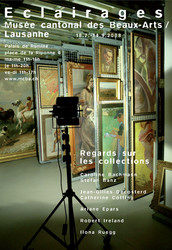"Eclairages. Regards sur les collections du musée"
MCBA - Musée cantonal des Beaux-Arts, Lausanne, Switzerland
18. 07. 2008 - 14. 09. 2008
Participating artists:
Marc-Louis Arlaud, René Auberjonois, Bachmann / Banz, Charles Blanc-Gatti, Jules Blancpain, François Bocion, Marius Borgeaud, Louis Buvelot, Gustave Courbet, Philippe Decrauzat, Francois Diday, Louis Ducros, Ariane Epars, Albert Gaeng, Charles Giron, Charles Gleyre, Ferdinand Hodler, Leiko Ikemura, Robert Ireland, Milo Martin, Jean Otth, Steven-Paul Robert, Théophile Robert, llona Ruegg, Jean Scheurer, Pierre Schwerzmann, Félix Vallotton, Alexis Vautier
The collections form the basis of any museum, determine its identity and give it a face. They are the raw material available to the curators whose role is to bring to light what lies dormant in the reserves. However, another point of view on the collections is possible: that of people whose approach is neither historical nor scientific, the subjective and particular view of artists or architects.
The Museum asked seven of them to update certain aspects of the collections, but also to cast a critical eye on the very principle of such a collection of works and on the conditions of their conservation/presentation. Eclairages thus combined the presentation of the collections with an exhibition of contemporary art, and allowed the public to discover hidden treasures or to rediscover what they already know from a new angle.
The architects Jean-Gilles Décosterd & Catherine Cotting were interested in one of the central parameters of the exhibition space, namely light, its variations, its determining impact on the "climate" of a place. For Eclairages, the two architects proposed to broaden the notion of "exhibition climate" by creating a light sheet capable of varying its intensity according to climatic changes. This dynamic lighting system (autonomously controlled by weather sensors placed in the Alps thanks to the infrastructure set up by the Swiss Experiment project of the Swiss Federal Institute for Snow and Avalanche Research [WSL/SLF]) directly linked the interior of a museum room to its environment. The device was completed by the application of two (anti-high-tech) materials used in architecture that interact with the local climate: compacted earth and a color with depolluting qualities.
Ariane Epars intervened in the space through sound, and proposed to make audible and thus present in the space all the artists and works that make up the Museum's collections, as an extension of a project conceived for the 100th anniversary of the Palais de Rumine. By broadcasting the names of all the artists and the title of each of their works, she creates a virtual space for a collection waiting for real spaces to unfold in all its magnitude.
Robert Ireland, who has been working for many years on the notions of exhibition, framing, and "neighborhoods" between works, as well as on museographic conventions and their possible misappropriations, placed in dialogue the works of the collection with works of his own, drawings and photographs made in the museum. He thus invested the exhibition space by exploring the reserves - in the double sense of deposits and lacks, of concrete spaces and absences - and by looking at the details of the paintings that usually escape us.
Publication:
"Eclairages. Regards sur les collections du Musée"
With texts by Caroline Bachmann, Stefan Banz, Jean-Gilles Décosterd, Catherine Cotting, Ariane Epars, Robert Ireland and Ilona Ruegg, edition MCBA, Lausanne.
Sources:
https://www.mcba.ch/expositions/eclairages-regards-sur-les-collections-du-musee/
https://recherche.sik-isea.ch/sik:exhibition-12495066/in/sikart/
